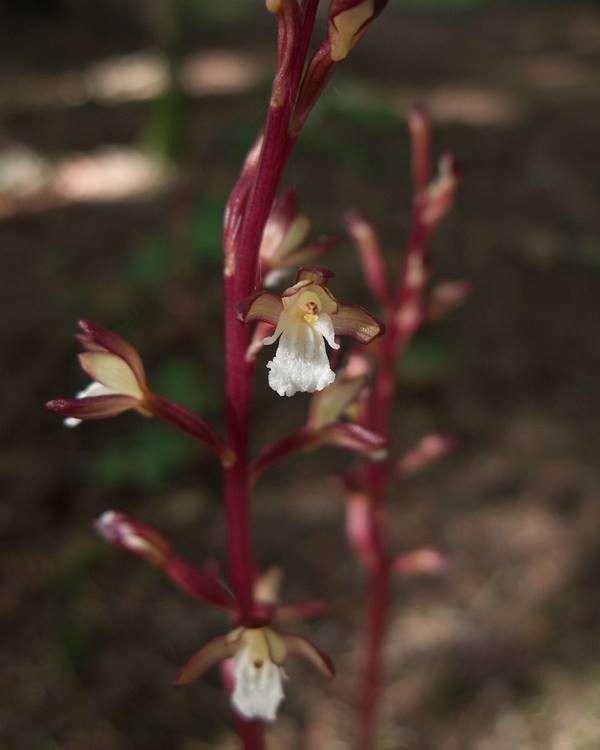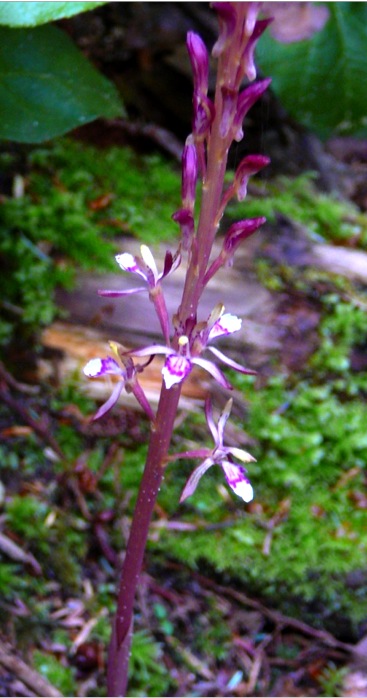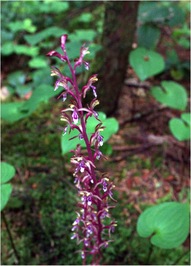Western coralroot • Corallorhiza mertensiana, Corallorhiza maculata ssp. mertensiana
Habitat & Range
Western coralroot grows in fairly dry coniferous or mixed forests with a rich humus (organic soil) layer, often in heavy shade. Its range extends north to 55˚N, east to Newfoundland and south to California, Arizona and New Mexico.
Similar Species
The similar-looking species spotted coralroot (Corallorhiza maculata) can be differentiated by the lip of its flowers, which is white with magenta spots.
Intriguing Info
Western coralroot, like other members of the Orchidaceae family, is a saprophyte: it gets its energy from dead organic matter rather than from photosynthesis. This is why they do not have the green colour caused by the presence of chlorophyll that is characteristic of most plants.
Western coralroot grows in fairly dry coniferous or mixed forests with a rich humus (organic soil) layer, often in heavy shade. Its range extends north to 55˚N, east to Newfoundland and south to California, Arizona and New Mexico.
Similar Species
The similar-looking species spotted coralroot (Corallorhiza maculata) can be differentiated by the lip of its flowers, which is white with magenta spots.
Intriguing Info
Western coralroot, like other members of the Orchidaceae family, is a saprophyte: it gets its energy from dead organic matter rather than from photosynthesis. This is why they do not have the green colour caused by the presence of chlorophyll that is characteristic of most plants.
References
Corallorhiza maculata (Raf.) Raf. In Klinkenberg, Brian. (Ed.). E-Flora BC: Electronic Atlas of the Plants of British Columbia. Lab for Advanced Spatial Analysis, Department of Geography, University of British Columbia, Vancouver. Accessed 6/25/2014.
Corallorhiza mertensiana Bong. In Klinkenberg, Brian. (Ed.). E-Flora BC: Electronic Atlas of the Plants of British Columbia. Lab for Advanced Spatial Analysis, Department of Geography, University of British Columbia, Vancouver. Accessed 6/25/2014.
Pojar, J. and MacKinnon, A. (1994). Plants of Coastal British Columbia. Vancouver, BC: Lone Pine Publishing. P. 119.
Authors and editors of page
Peter Gibbs, Kelly Fretwell, and Brian Starzomski (2014).
Corallorhiza maculata (Raf.) Raf. In Klinkenberg, Brian. (Ed.). E-Flora BC: Electronic Atlas of the Plants of British Columbia. Lab for Advanced Spatial Analysis, Department of Geography, University of British Columbia, Vancouver. Accessed 6/25/2014.
Corallorhiza mertensiana Bong. In Klinkenberg, Brian. (Ed.). E-Flora BC: Electronic Atlas of the Plants of British Columbia. Lab for Advanced Spatial Analysis, Department of Geography, University of British Columbia, Vancouver. Accessed 6/25/2014.
Pojar, J. and MacKinnon, A. (1994). Plants of Coastal British Columbia. Vancouver, BC: Lone Pine Publishing. P. 119.
Authors and editors of page
Peter Gibbs, Kelly Fretwell, and Brian Starzomski (2014).






